When Rep. Gabrielle Giffords and 18 others were shot outside a Tucson grocery store Saturday, just one local hospital was capable of treating the most seriously injured.
Tucson's University Medical Center is Southern Arizona's only remaining Level One Trauma Center. That means it's the region's sole hospital equipped to handle patients with the most severe injuries - those likely to cause death or significant disability in children and adults.
A second local Level One Trauma Center, operated by Tucson Medical Center, closed in 2003. At the time, the TMC trauma center closure caused outcry and fear. Doctors, nurses and other community leaders predicted disastrous outcomes for Southern Arizona, saying the population here is too big for just one top-level trauma center.
The greater Tucson area alone has slightly more than 1 million residents. Arizona has eight top-level trauma centers - one in Tucson, one in Flagstaff and six in the Phoenix area, state health officials say.
As recently as 2008, UMC was battling a shortage of trauma surgeons - it had just two full-time, aided by two part-time trauma surgeons who flew in from New York and Phoenix.
The scenario is much different now due to a major expansion of the surgery department. There are seven full-time trauma surgeons on staff, and hired in the past three years.
The University of Arizona's ability to attract surgeons improved in 2007 after it hired nationally renowned transplant surgeon Dr. Rainer Gruessner as chief of surgery. Gruessner came to UMC and the UA College of Medicine from the University of Minnesota.
Gruessner recruited trauma surgeon Dr. Peter M. Rhee to become medical director of UMC's trauma center. Rhee in turn replenished the trauma staff with surgeons. Among them was Dr. Randall Friese, who came to Tucson from the University of Texas Southwestern Medical Center and who first assessed Giffords when she came into the hospital after the shooting.
Friese has received worldwide recognition for his research on the impact of sleep on recovery from critical illness and injury. He is also leading a local study that's part of a high-profile national trial on the use of progesterone in brain-trauma patients.
Harder to recruit have been neurosurgeons. The department, which has a neurosurgeon available 24/7, includes three full-time neurosurgeons plus one part-time.
But Rhee hired division chief Dr. G. Michael Lemole Jr. in October 2009, and Lemole said Tuesday that he is in the process of doubling his staff to six by adding a neurosurgeon who specializes in pediatrics, another in the spine and and another in endovascular neurosurgery.
Lemole said Gruessner has given his department the resources to achieve the goal and also to attract "the brightest and best." Lemole performed Giffords' surgery Saturday along with Dr. Martin E. Weinand. Giffords was in surgery within 38 minutes of arriving at the hospital.
"Thirty-eight minutes is phenomenal. One thing I noticed Saturday was how well the system worked. The stars kind of aligned right," said Joel Bunis, office chief of the state's bureau of public health emergency preparedness.
Rhee said the trauma center was well-prepared to handle the influx of patients from Saturday's shooting rampage and could have handled more if needed. He noted that UMC has faced larger mass casualties in recent years, including a rollover involving 30 people.
He said the only impact of Saturday's shootings on UMC operations was that for two hours - between 11 a.m. and 1 p.m. Saturday - the hospital's emergency department was on "divert" status, meaning that except for trauma cases, ambulances were directed to other hospitals.
Rhee said the Tucson area doesn't need two Level One trauma centers. Now that staffing has improved, local residents should be confident that UMC is ready to handle mass casualties with top-level care, he said.
"The volume we that have here, you have to have a certain (patient) volume to stay as a Level One," Rhee said. "You need that volume to be able to teach your residents and everything and have enough of a volume that it's an interesting enough of job that you attract high-caliber people to come."
Rhee said the addition of a Level Three designated trauma center at University Physicians Healthcare Hospital at Kino this year will help create a more coordinated system of trauma care across Southern Arizona. Trauma centers range from Level Four, which stabilize patients and treat less-serious injuries, to Level One.
"Just because there's just one (Level One) in the area is not necessarily a bad thing. It can serve as a focus point for the other hospitals to feed into. It's one big system," Bunis said. "The way to know if there's a need for more Level Ones in an area is if - let's say UMC's last event - if they couldn't handle it. But they could."
One thing I noticed Saturday was how well the system worked. The stars kind of aligned right."
Joel Bunis, office chief of Arizona's bureau of public health emergency preparedness
Contact Stephanie Innes at 573-4134 or sinnes@azstarnet.com





